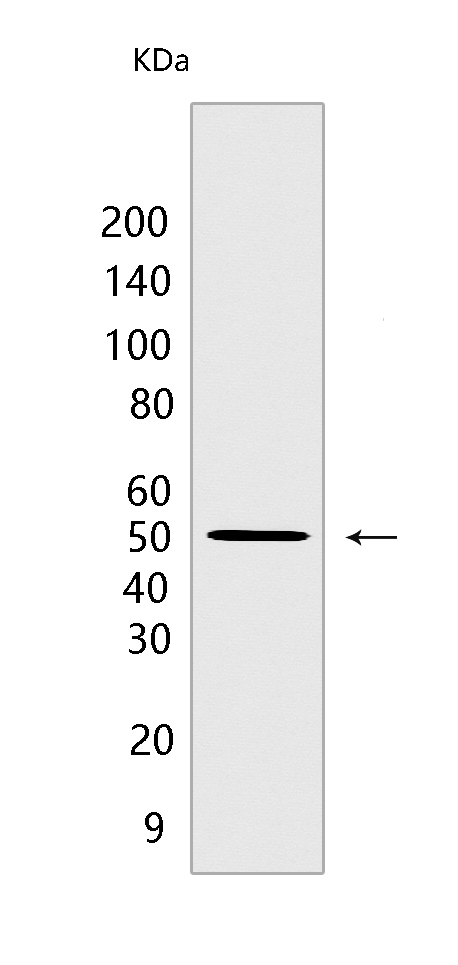MST3 Rabbit mAb [1Q89]Cat NO.: A82857
Western blot(SDS PAGE) analysis of extracts from A431 cells.Using MST3Rabbit mAb [1Q89] at dilution of 1:1000 incubated at 4℃ over night.
Product information
Protein names :STK24,MST3,STK3,STK24_HUMAN,Serine/threonine-protein kinase 24 [Cleaved into: Serine/threonine-protein kinase 24 36 kDa subunit ,Serine/threonine-protein kinase 24 12 kDa subunit ]
UniProtID :Q9Y6E0
MASS(da) :49,308
MW(kDa) :52 kDa
Form :Liquid
Purification :Protein A purification
Host :Rabbit
Isotype :IgG
sensitivity :Endogenous
Reactivity :Human
- ApplicationDilution
- 免疫印迹(WB)1:1000-2000
- 免疫组化(IHC)1:100
- 免疫荧光(ICC/IF) 1:100
- The optimal dilutions should be determined by the end user
Specificity :Antibody is produced by immunizing animals with a synthetic peptide at the sequence of human MST3
Storage :Antibody store in 10 mM PBS, 0.5mg/ml BSA, 50% glycerol. Shipped at 4°C. Store at-20°C or -80°C. Products are valid for one natural year of receipt.Avoid repeated freeze / thaw cycles.
WB Positive detected :A431 cells
Function : Serine/threonine-protein kinase that acts on both serine and threonine residues and promotes apoptosis in response to stress stimuli and caspase activation. Mediates oxidative-stress-induced cell death by modulating phosphorylation of JNK1-JNK2 (MAPK8 and MAPK9), p38 (MAPK11, MAPK12, MAPK13 and MAPK14) during oxidative stress. Plays a role in a staurosporine-induced caspase-independent apoptotic pathway by regulating the nuclear translocation of AIFM1 and ENDOG and the DNase activity associated with ENDOG. Phosphorylates STK38L on 'Thr-442' and stimulates its kinase activity. In association with STK26 negatively regulates Golgi reorientation in polarized cell migration upon RHO activation (PubMed:27807006). Regulates also cellular migration with alteration of PTPN12 activity and PXN phosphorylation: phosphorylates PTPN12 and inhibits its activity and may regulate PXN phosphorylation through PTPN12. May act as a key regulator of axon regeneration in the optic nerve and radial nerve..
Tissue specificity :Isoform A is ubiquitous. Isoform B is expressed in brain with high expression in hippocampus and cerebral cortex.
Subcellular locationi :Cytoplasm. Nucleus. Membrane.
IMPORTANT: For western blots, incubate membrane with diluted primary antibody in 1% w/v BSA, 1X TBST at 4°C overnight.


